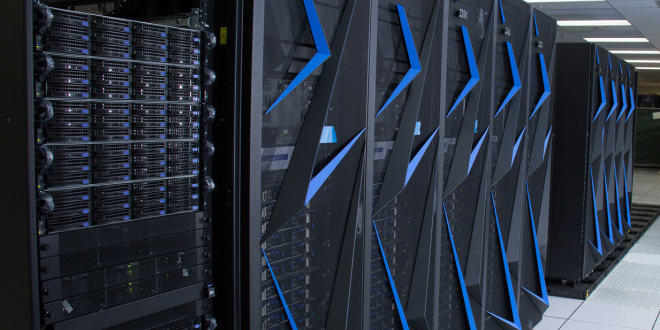
Sierra, Livermore’s latest advanced technology high performance computing system, joined LLNL’s lineup of supercomputers in 2018. The new system provides computational resources that are essential for nuclear weapon scientists to fulfill the National Nuclear Security Administration’s stockpile stewardship mission through simulation in lieu of underground testing. Advanced Simulation and Computing (ASC) Program scientists and engineers will use Sierra to assess the performance of nuclear weapon systems as well as nuclear weapon science and engineering calculations. These calculations are necessary to understand key issues of physics, the knowledge of which later makes its way into the integrated design codes. This work on Sierra has important implications for other global and national challenges such as nonproliferation and counterterrorism.
The IBM-built Sierra supercomputer is providing over six times the sustained throughput performance and over five times the sustained scalable science performance of Sequoia, with a 125 petaflops peak. Sierra, which combines two types of processor chips — IBM’s Power 9 processors and NVIDIA’s Volta graphics processing units, is over five times more power efficient than Sequoia, with a peak power consumption of approximately 11 megawatts.
Additional Resources
For the Public
For Users
| Zone |
SCF
|
| Vendor |
IBM
|
| User-Available Nodes |
Login Nodes*
5
Batch Nodes
4,284
Debug Nodes
36
Total Nodes
4,474
|
| CPUs |
CPU Architecture
IBM Power9
Cores/Node
44
Total Cores
190,080
|
| GPUs |
GPU Architecture
NVIDIA V100 (Volta)
Total GPUs
17,280
GPUs per compute node
4
GPU peak performance (TFLOP/s double precision)
7.00
|
| Memory Total (GB) |
1,382,400
|
| CPU Memory/Node (GB) |
256
|
| Peak Performance |
Peak TFLOPS (CPUs)
4,666.0
Peak TFLOPs (GPUs)
120,960.0
Peak TFLOPS (CPUs+GPUs)
125,626.00
|
| Clock Speed (GHz) |
3.4
|
| Peak single CPU memory bandwidth (GB/s) |
170
|
| OS |
RHEL
|
| Interconnect |
IB EDR
|
| Recommended location for parallel file space |
/p/gpfs1
|
| Program |
ASC
|
| Class |
ATS-2, CORAL-1
|
| Year Commissioned |
2018
|
| Compilers | |
| Documentation |
